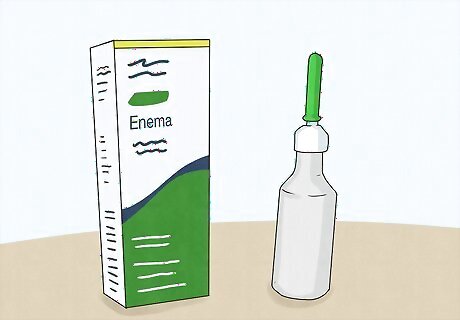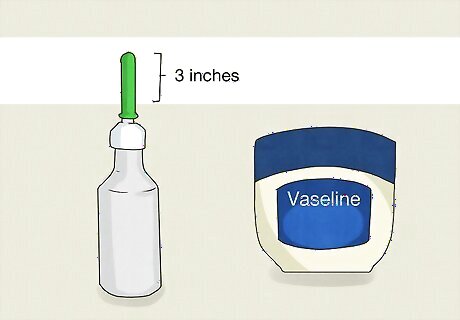
views
- Mix up your enema solution (either a saline solution or one from an enema kit). Spread lube onto the enema nozzle to make it easier to insert.
- Put towels on the bathroom floor, then lie down with your knees to your chest. Insert the nozzle 3 in (7.6 cm) into your rectum.
- Hang the enema bag up and let gravity push the fluid into your rectum. Take the nozzle out, then hold the enema in for 5 to 15 minutes.
- Release the enema fluid into the toilet.
Preparing the Enema Bag and Tube

Talk to your doctor before you perform your own enema. While it's typically safe to have an enema, it's probably still a good idea to talk to your doctor about it first. They may advise you to try other methods of relieving your constipation first, like taking a fiber supplement or an over-the-counter laxative, if you haven't already. If they do recommend an enema, they can tell you how often you should perform the enema or what to do if it doesn't relieve your constipation symptoms. In some cases, your doctor may ask you to perform an enema before you come in for a procedure like a colonoscopy.

Mix up your own solution if you're using a saline enema. Unless your doctor tells you otherwise, it's safest to use a simple saline solution when you're performing an enema. Making your own saline solution is easy—just stir 2 tsp (12 g) of table salt into 1,000 ml (1.1 qt) of lukewarm distilled water. Purchase distilled water, as tap water may contain contaminants that you don't want to introduce into your rectum. If you're making a homemade enema solution, you'll also need to purchase an enema bag and tube. Do not add any other ingredients to the saline solution unless your doctor advises you to. Even if you see them recommended online or by your family and friends, do not put fruit juices, herbs, vinegar, coffee, or alcohol into your enema. The risks posed by introducing these substances into your colon far outweigh any potential benefits. Once you've made the saline, fill the enema bag with 6 fluid ounces (180 ml) for children 2-6 years old, 12 fluid ounces (350 ml) for children 6-12 years old, and 16 fluid ounces (470 ml) for anyone 13 or older. Do not give an enema to children under the age of 2 unless directed to do so by your doctor.

Purchase an enema kit if your doctor recommends a mineral oil or phosphate enema. Mineral oil and phosphate are both used as laxatives, so they can increase the effectiveness of your enema. Mineral oil can be less irritating than a phosphate enema, but talk to your doctor before you use either. Typically, store-bought enemas come in children's and adult's sizes. Read the label carefully to ensure you get the right enema for your age and body size. Small children and older adults should not be given phosphate enemas, because they can lead to a dangerous electrolyte imbalance. For a mineral oil enema, the dose is 2 fluid ounces (59 ml) for children ages 2-6 and 4.5 fluid ounces (130 ml) for anyone older than 6. If you're using a phosphate enema, the dose is 1 fluid ounce (30 ml) for children who weigh 20 pounds (9.1 kg) or more, 2 fluid ounces (59 ml) for children who weigh at least 40 pounds (18 kg), 3 fluid ounces (89 ml) for someone who weighs 60 pounds (27 kg) or more, 4 fluid ounces (120 ml) for anyone 80 pounds (36 kg) lb, and 4.5 fluid ounces (130 ml) if the person weighs 90 pounds (41 kg) or more.

Lubricate the nozzle tip on the enema tube. Coat the last 3 in (7.6 cm) of the nozzle with petroleum jelly or a water-based personal lubricant. This will make it easier and more comfortable to insert the nozzle when you begin the enema. If you'd like, you can also spread a little of the lubricant around your rectal area.
Administering the Enema

Place folded towels on the bathroom floor. Since you may have to get to the toilet very quickly, it's best to perform an enema in your bathroom. The bathroom is also the best place to ensure you have privacy during the procedure. To set up your area, lie several folded towels on the bathroom floor so you'll have a comfortable place to rest while you wait. Make sure there's a place nearby where you can place the enema bag while you wait, like a small stool or a hook you can hang it from. You may also want to have a book or magazine nearby so you'll have something to read while you're performing the enema.

Lie on the floor and pull your knees up to your chest. When you're ready to begin your enema, remove your bottoms and make sure your enema supplies are near the towels you placed on your floor. Then, lie flat on your back, bringing your knees up until you can easily reach your bottom. If lying on your back is difficult, you can lie on your left side. Choose whichever position is more comfortable for you. It may help to use a hand mirror so you can see what you're doing better.

Insert the tip of the nozzle 3 in (7.6 cm) into your rectum. If there's a cap on the nozzle, take it off. Then, very gently, push the tip of the nozzle into your bottom. Don't force the tip in, and take your time. This may feel a little uncomfortable, but it shouldn’t be painful. The nozzle tip should be rounded to make it easier to insert. If you're giving the enema to a child, only insert it 1 ⁄2–2 in (3.8–5.1 cm) into their rectum. Having trouble with insertion? Try bearing down like you’re taking a bowel movement. Many people find that this helps the nozzle go into their rectum easier.

Place or hang the enema bag 1–2 ft (0.30–0.61 m) higher than your rectum. Set the bag on a sturdy surface or hang it from a small hook so it's slightly elevated. That way, gravity will work to empty the contents of the bag into your rectum, and you won't have to hold up the bag the entire time. If you're using a disposable enema, you may need to squeeze the contents of the container into your rectum. If that's the case, do this slowly, and be sure to empty the entire bag.

Take deep breaths to help you relax. If it’s your first time administering an enema, the feeling can be a little strange. Focus on breathing slowly in and out, and try to relax your rectum as much as possible. Make sure you aren’t trying to push the enema nozzle out, as that can cause it to leak. Try to think about how much better you’ll feel after the enema is done.

Allow the bag to empty, then remove the nozzle. It will probably take about 5-10 minutes for the entire enema solution to empty into your rectum. While you're waiting, relax as much as possible, and try not to move. Once the bag is empty, carefully and slowly slide the nozzle out of your rectum. It may help if you have something to distract yourself during this time, like a book, some music, or a game on your phone. If you experience any cramping, lower the bag slightly, which will slow the flow of the solution.

Try to hold in the enema for 5-15 minutes. Once you remove the nozzle, lie still and try to hold back the urge to eliminate your bowels for as long as possible. It's best to hold in the enema for about 15 minutes, but even waiting 5-10 minutes may be enough to help stimulate your bowels.

Release the enema liquid into the toilet. After 15 minutes, or when you can't hold it in any longer, carefully get up and move to the toilet. Then, release your bowels to expel the enema fluid. Afterward, shower or use a wet wipe to clean any remaining lubricant from around your bottom. You may have a bowel movement at this time, but it's okay if you don't. It's a good idea to stay close to the toilet for the next hour or so, as you may have another bowel movement during that time. After an hour, though, you’re free to resume your normal activities. You may experience stomach cramps for a short while after having the enema. If you feel a little faint or dizzy after your enema, lie down until the feeling passes.

Sterilize or dispose of the enema equipment. If you purchased reusable enema equipment, wash the nozzle and tube thoroughly with soapy water, then sterilize the pieces by placing them in boiling water for about 10 minutes. Rinse the enema bag with warm water. If you used a disposable enema kit, you can throw all of the equipment away when you're finished.
When to Seek Medical Attention

See your doctor if you haven't passed a bowel movement in 3 days. While an enema can be a quick way to relieve constipation, if you haven't had a bowel movement in 3 days, it's important to talk to your doctor. They can help you determine whether there's a problem that's causing your constipation, and you can ask them whether an enema might be a good option. If this is a recurring problem, your doctor might also recommend certain lifestyle changes to relieve chronic constipation, like drinking more water or eating more fiber.

Call your doctor if you experience side effects after your enema. While it's normal to feel a little lightheaded or have some stomach cramping after an enema, more severe side effects could be an indication of an internal injury. Call your doctor and ask to be seen right away or visit an emergency room if you experience any of the following after an enema: Feeling very dizzy, weak, or tired Fainting Developing a rash Being unable to pass urine Having severe, extended diarrhea Worsening constipation Experiencing swelling in your hands or feet

Visit the ER immediately if you have rectal bleeding or severe abdominal pains. Giving yourself an enema carries the risk of perforating the side of your bowel wall. That can be a very dangerous condition, so call for emergency medical assistance right away if you have any bleeding from your rectum or if you have severe pains or cramps in your stomach or lower back. You might also experience fever, chills, nausea, or vomiting.













Comments
0 comment